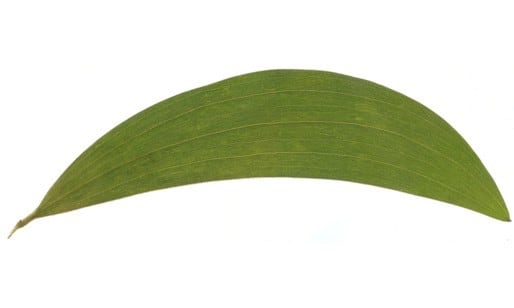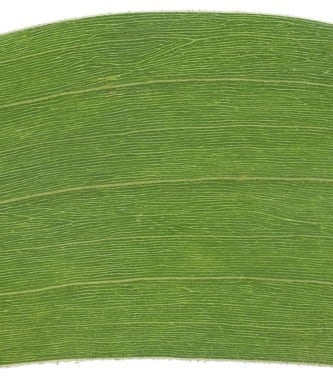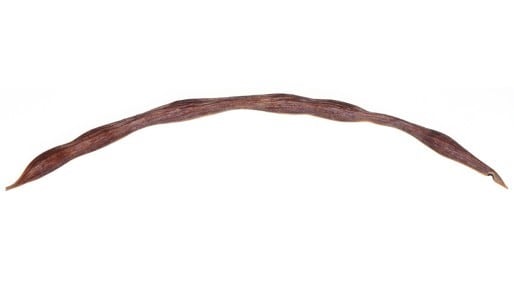Acacia difficilis Maiden
WATTLE
Acacias of Australia
Common Name
River Wattle
Family
Fabaceae
Distribution
Common in northern N.T. extending S from the Tiwi Is. to the Newcastle Waters region; ranging W to the Kununurra area, W.A., and E along the Gulf of Carpentaria to far NW Qld.
Description
Shrub or tree, 2–10 m high. Bark of trunk and branches fibrous, reddish brown. Branchlets almost terete, grey-brown, densely pubescent or glabrous except in axils. Phyllodes elliptic to narrowly elliptic, subfalcate to dimidiate, (5.5–) 7–16 cm long, 15–40 mm wide (to 20 cm long and 70 mm wide on young plants), thinly coriaceous, silvery-white and densely pubescent when young, later often glabrescent, rarely lightly pruinose; with 5–9 ±prominent longitudinal nerves (ventral nerves becoming confluent with or near lower margin at base); minor nerves 5–10 per mm, sometimes sparingly anastomosing. Inflorescences simple or racemose, racemes 1–75 (–200) mm long; peduncles 1–7 mm long, hairy or scurfy or sometimes glabrous; spikes (1–) 2–3 (–5) per node, 1.5–4 (–5) cm long, lemon yellow to golden. Flowers 5-merous; sepals partially united, silky pubescent. Pods linear, submoniliform, terete to subterete, straight or curved, 3–15.5 cm long, 3–4 mm wide, coriaceous, longitudinally striate, glabrous or sparsely hairy. Seeds longitudinal, oblong-elliptic, 5–9 mm long, 2–4 mm wide, black; pleurogram indistinct; areole open, depressed.
Phenology
Flowers May–Aug.
Habitat
Grows usually in sandy or gravelly soils, often near watercourses, frequently associated with Eucalyptus tetrodonta.
Specimens
W.A.: 27.5 km SE of Kununurra on Duncan Hwy, B.R.Maslin 5145 (BRI, DNA, PERTH). N.T.: Jim Jim Ck, M.Lazarides 7642 (BRI, CANB, DNA, K, L, NSW, US); Darwin R. crossing, Cox Peninsula road, G.J.Leach 3257 (BRI, DNA, NSW, PERTH); 5 km NE of Cahills Crossing, towards Oenpelli, M.D.Tindale 10060 & P.Munns (DNA, MO, NSW). Qld: Thursday Is., W.S.Campbell 1911 (NSW).
Notes
Acacia difficilis is a member of the ‘A. tumida group’ that is similar to, and sometimes confused with, A. tumida var. tumida, especially from herbarium material. Acacia difficilis is most readily distinguished by its mainly dimidiate phyllodes, calyces with relatively long, spreading hairs (short and erect in var. tumida), narrower pods with longitudinally arranged seeds (see M.W.McDonald, Austral. Syst. Bot. 16: 147 (2003) for further discussion). Acacia difficilis produces natural hybrids with A. tumida var. tumida, A. mountfordiae and A. torulosa, see M.W.McDonald, loc. cit., for discussion. Flowering specimens can sometimes be confused with A. lamprocarpa, a member of the ‘A. aulacocarpa group’ distinguished by its shallowly dissected, glabrous calyx.
Details of biology, ecology, utilisation, etc. of A. difficilis are given in J.W.Turnbull (Ed.), Multipurpose Austral. Trees & Shrubs 130 (1986) and M.W.McDonald, loc. cit.
Most adult plants of A. difficilis are glabrate but in the Daly R. region and the Tiwi Is. they are moderately to densely hairy. Pruinose forms occur in some areas, fide M.W.McDonald, loc. cit.
FOA Reference
Data derived from Flora of Australia Volumes 11A (2001), 11B (2001) and 12 (1998), products of ABRS, ©Commonwealth of Australia
Author
Edited by B.R.Maslin
Dr M.D.Tindale and Dr P.G.Kodela with the assistance of M.Bedward, S.J.Davies, C.Herscovitch, D.A.Keith and/or D.A.Morrison
This identification key and fact sheets are available as a mobile application:
URL: https://apps.lucidcentral.org/wattle/
© Copyright 2018. All rights reserved.













